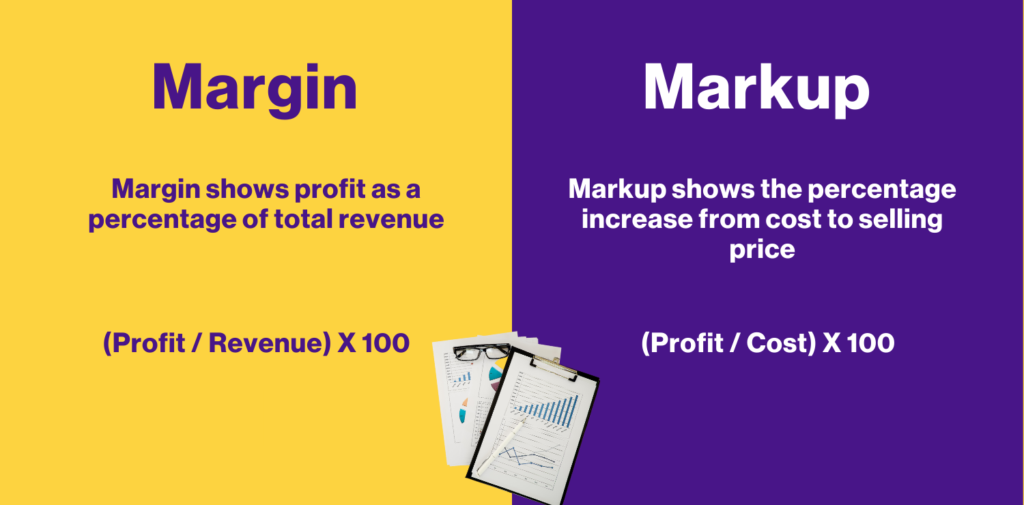Margin is profit as a percent of revenue, while markup is the percentage difference between cost and selling price.
Since the terms can be used interchangeably, knowing the difference between margin vs markup can be tricky.
To begin, here are the respective margin and markup formulas.

Margin vs. Markup Video Walkthrough
If the formulas alone are confusing on their own, don’t worry. Let’s do a video walkthrough of how we use them in practice.
Essential Definitions
Understanding margin and markup is important for ensuring profitably set prices. If they’re too low or too high, this can result in lost sales or revenue. But before we learn to calculate markup vs margin, there are some essential definitions we need to cover.
Revenue is the money your company earns from selling products or services.
Cost of goods sold (COGS) is the total direct cost of producing a good or service. This may include raw materials, equipment, and wages paid to workers directly involved in the process.
Operating expenses include all indirect costs of running a business, such as rent, marketing, and administrative costs.
Gross profit refers to revenue left over after deducting COGS.
Operating profit measures profit after removing both COGS and operating costs.
Net profit is the truest measure of profit, representing what remains after deducting all business expenses.
For more detailed information, read our article on net vs. gross income.
How Do You Calculate Margin?
Profit margin measures your profit as a percentage of revenue.
In other words, what proportion of your revenue translates to profit?
There are many variations of the term: net profit margin, operating profit margin, unit margin, and gross profit margin. We’ll cover each of these below, but when most people talk about “margin,” they usually refer to gross margin: profit from a sale after deducting COGS.

Margin Formula
We calculate percentage profit by deducting costs from revenue, dividing by revenue, then multiplying by 100.
Margin = (Revenue – Costs)/Revenue x 100
Understanding margin is more complicated than the high-level formula might suggest. Depending on which information you include, there are many different types of margin you may calculate, each providing unique insights into your business.

How Do You Calculate Markup?
While margin shows how much profit you’re making as a percentage of revenue, markup shows sale prices as a percentage of cost. Markup calculations are an essential tool for financial modeling, allowing business owners to determine how many sales and at what price they’ll need to reach different levels of profitability.
Markup Formula
Markup refers to how much a single unit’s price is increased over its cost. The markup formula deducts costs from the sale price, then divides by cost, and finally multiplies by one hundred.
Markup = (Sale Price – Cost)/Cost x 100
Markup vs Margin Formula Examples
Sometimes, it’s easier to learn through an example than a formula or definition.
Let’s suppose your company white labels software as part of a comprehensive services package. Your clients could go directly to the supplier, but it’s easier to go through you since you manage other aspects of their business as well.
Since markup is usually calculated on a per-unit basis, we’ll do a unit margin calculation as well. Your supplier charges $70 per user and you charge customers $100. After running calculations through their respective formulas, you discover that you’re charging a 42% markup while running a 30% margin.

Markup Calculator
Markup
0.00%
Formula: Markup = ((Revenue – Costs) / Costs) × 100
Margin Calculator
Margin
0.00%
Formula: Margin = ((Revenue – Costs) / Revenue) × 100
How to Use Markup and Margin In Your Business
You could benchmark your business against competitors in your industry to learn if you’re over or underperforming compared to your peers.
For instance — in January 2024, the NYU Stern School of Business put together a margin analysis of over 6,000 businesses across nearly one hundred sectors. We’ve pulled a handful below, but encourage you to look into the source material if your business is missing here.

Is Your Business Profitable?
You might be surprised to hear this, but many business owners don’t actually know (for sure) whether or not they’re profitable. We cover some of the reasons in our webinar, How to Do Financial Forecasting, but the culprit usually comes down to never sitting down and doing the math.
So, start by comparing your company to industry peers. If they’re different, ask yourself why.
Are you charging enough?
Are your costs too high?
And what strategies can you implement to improve?
These are the sorts of questions indinero virtual cfo, Brian Johnson, pursues every day. Here’s a firsthand experience he had with a client:
“We have a client who came to us when they were breaking even, and the founder was concerned about whether he was going to make it. We ran through a financial analysis of their margins and discovered that some of their products, after considering fixed costs and variable profits, weren’t making money. So over six months, we achieved profitability by cutting his cost structure and right sizing his business.”
Margin and markup analysis can also bring good news. If you’re outperforming the competition, it may be a good time to pursue an exit through a merger or acquisition, additional investment from venture capitalists, or further growth by applying for a business loan.
If you need help with this sort of analysis, accounting, or bookkeeping, contact an indinero virtual CFO services expert today.
We’ll take care of the numbers. You focus on growth.




